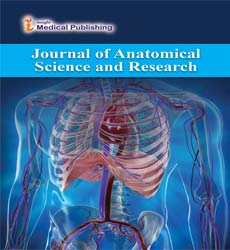Mitochondria- The Power House ofthe Cell
Nova Radjah*
Department of Neuroscience, State University of Malang, Malang, Indonesia
- *Corresponding Author:
- Nova Radjah
Department of Neuroscience
State University of Malang
Malang, Indonesia
Tel: +62 703013341
E-mail: novaradja@gmail.com
Received Date: February 12, 2021 Accepted Date: February 26, 2021 Published Date: March 5, 2021
Citation: Radjah N (2021) Mitochondria- The Power House of the Cell. J Anat Sci Res. Vol. 4 No.1: e001.
Editorial Note
The mitochondrion is a double membrane-bound organelle found in most eukaryotic organisms. Some cells in some multicellular organisms lack mitochondria (for example, mature mammalian red blood cells). A number of unicellular organisms, such as microsporidia, parabasalids, and diplomonads, have reduced or transformed their mitochondria into other structures. To date, only one eukaryote, Monocercomonoides, is known to have completely lost its mitochondria, and one multicellular organism, is known to have retained mitochondrion related organelles in association with a complete loss of their mitochondrial genome. Mitochondria generate most of the cell's supply of adenosine triphosphate (ATP), used as a source of chemical energy. A mitochondrion is thus termed the powerhouse of the cell. Mitochondria are commonly between 0.75 and 3 μm² in area but vary considerably in size and structure. Unless specifically stained, they are not visible. In addition to supplying cellular energy, mitochondria are involved in other tasks, such as signaling, cellular differentiation, and cell death, as well as maintaining control of the cell cycle and cell growth. Mitochondrial biogenesis is in turn temporally coordinated with these cellular processes. Mitochondria have been implicated in several human diseases and conditions, such as mitochondrial disorders, cardiac dysfunction, heart failure and autism. The number of mitochondria in a cell can vary widely by organism, tissue, and cell type. A mature red blood cell has no mitochondria, whereas a liver cell can have more than 2000. The mitochondrion is composed of compartments that carry out specialized functions. These compartments or regions include the outer membrane; inter membrane space, inner membrane, cristae and matrix. Although most of a cell's DNA is contained in the cell nucleus, the mitochondrion has its own genome ("mitogenome") that is substantially similar to bacterial genomes. Mitochondrial proteins (proteins transcribed from mitochondrial DNA) vary depending on the tissue and the species. In humans, 615 distinct types of proteins have been identified from cardiac mitochondria, whereas in rats, 940 proteins have been reported. The mitochondrial proteome is thought to be dynamically regulated. Mitochondria's primary function is to produce energy through the process of oxidative phosphorylation. Besides this, it is responsible for regulating the metabolic activity of the cell. It also promotes cell multiplication and cell growth. Mitochondria also detox ammonia in the liver cells. Moreover, it plays an important role in apoptosis or programmed cell death.
In animal and in vitro models, it has been demonstrated that differentiated ECs are characterized by glycolytic formation of adenosine 5′-triphosphate (ATP) for energy production and have mitochondrial respiration as the secondary source of ATP. It has been shown that ECs increase glycolysis in response to angiogenic activation, a condition with metabolic characteristics similar to proliferative cancer cells. Glycolysis is not efficient for ATP production because only 2 ATP molecules per glucose molecule are generated, whereas mitochondrial respiration produces 36 ATP molecules per glucose molecule. The need for glycolysis in cancer cells was discovered recently because lactate can be used to produce building blocks for biosynthesis, which is needed in proliferating cells. However, regulation of mitochondrial respiration and thus oxidative phosphorylation can also occur in cancer cells when needed, indicating flexibility of cancer cells in ways to generate ATP.
Open Access Journals
- Aquaculture & Veterinary Science
- Chemistry & Chemical Sciences
- Clinical Sciences
- Engineering
- General Science
- Genetics & Molecular Biology
- Health Care & Nursing
- Immunology & Microbiology
- Materials Science
- Mathematics & Physics
- Medical Sciences
- Neurology & Psychiatry
- Oncology & Cancer Science
- Pharmaceutical Sciences
